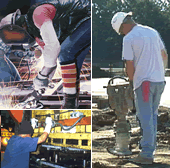Summary of NIOSH Back Belt Studies
ERGONOMICS AND MUSCULOSKELETAL DISORDERS

NOTE: This page is archived for historical purposes and is no longer being maintained or updated.
In two 1994 NIOSH publications, (Pub. No. 94-122) and (Pub. No. 94-127), NIOSH concluded that there was insufficient evidence to recommend the use of back belts as a back injury prevention measure. Since then, NIOSH conducted a large epidemiologic study and two laboratory evaluations to determine more conclusively the effects of back belt use. They do not provide evidence to change NIOSH's earlier conclusions.
To examine the effects of back belt use on back injuries in the workplace, a large, prospective cohort study was conducted among material handlers in a retail setting. Controlling for multiple individual risk factors, this study found that elastic support back belt use was not associated with reduced incidence of back injury claims or low back pain (Wassell, et al., Journal of the American Medical Association, 284 ( 21), December 6, 2000).
Two laboratory evaluations examined the physiological and human motion effects of the same belt as used in the prospective cohort study. A laboratory evaluation of the physiological effects of belt use found a significant reduction in mean oxygen consumption, but no significant effect on heart rate, blood pressure, or breathing rate (Bobick, et al., Applied Ergonomics, 32(6), 2001). An evaluation of the effects of the elastic back belt on human body motion during box-lifting tasks found that use of the belt significantly reduced the distance of forward spine bending and the velocities of forward-and-backward-spine-bending among subjects in the laboratory setting (Giorcelli, et al., Spine, 26(16), August 15, 2001). Unlike the epidemiologic study, these laboratory evaluations did not examine the association between back belt use and the outcomes of back injury or back pain.
In summary, recently completed research found that belt use reduced spine bending in laboratory trials. However, elastic support back belt use among retail material-handlers was not associated with reduced back injuries or back pain.
- Page last reviewed: October 7, 2013
- Page last updated: October 7, 2013
- Content source:
- National Institute for Occupational Safety and Health Division of Applied Research and Technology


 ShareCompartir
ShareCompartir